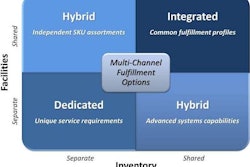
The term isn’t new and neither is the concept. The online phenomenon of “flash mobs” has hit the streets and continues to become more evident, so much so that television host and producer Howie Mandel devotes an hour each week to air his show “Mobbed” on Fox.
Yet, there’s a different kind of flash mob in town and this one doesn’t involve swarms of dancing people. Otherwise known as “flash demand,” the model refers to the pressures that such reality TV shows as “Fashion Star” and “Project Runway” create in the retail space. And let’s not forget the impact that utilizing social networks to grow a brand name and create product awareness—in any segment, not just retail—has on the market.
Hosted by Elle Macpherson, NBC’s “Fashion Star” gives designer contestants a chance not only at the money but to launch their collections in retail giants Macy's, H&M and Saks Fifth Avenue. At the end of each episode, viewers and consumers have the chance to immediately purchase the winning designs showcased on the episode that week. And what viewers see on TV that night will be on the streets and in stores immediately.
Now, whether the search for the next big fashion brand interests you or not, the potential supply chain impact of the show is worth noting.
Whichever form factor it may be—whether a reality TV show that releases designer creations the next day or an overnight NBA sensation who creates a surplus of sports memorabilia market demand—it is important to understand what such “flash demand” drivers mean across all supply chain processes and players involved.
Examining the logistics
“The term ‘flash demand’ really came about when we started thinking about what retailers observe in the market in terms of new demand signals and how quickly they emerge—and then how they read those demand signals,” explained Guy Courtin, Director of Industry Solutions, Supply Chain for Progress Software Corp., a business process management software provider based in Bedford, Mass. “But then also integrating this whole notion of the flash mob and how these really spring up from a ground swell. It’s something that is really adding a little complexity for retailers that some may have trouble dealing with.”
Suffice to say, the number of challenges facing retailers is not few and far between as many of them continue to struggle with consumer price sensitivity and unpredictable demand swings while at the same time working to identify new market opportunities and implement effective supply chain strategies.
And while a number of these unpredictable demand swings are left in the past—the Kathie Lee Gifford child labor allegations or the pressure grocery retailers faced in meeting carbohydrate consumer demand during the 2003 Atkin’s Diet craze—the challenges and opportunities that “flash demand” creates will only continue to develop as technology advances and consumer demand grows.
“If we break down retailers into three categories—perishable goods, durable goods and consumable goods—this notion of flash demand will impact each of them differently,” Courtin continued. “A grocery store won’t have the same fluctuation and demand as a demand signal that comes from another retail sector. And while these types of demands put a lot of strain on retailers, these occurrences will only increase as the manufacturers try to take advantage of current situations,” he said, e.g., a spike in demand for sports memorabilia, such as what occurred when Jeremy Lin reached nationwide stardom.
Addressing the challenges
Ordering too much inventory leaves stores with unwanted surplus. And not having enough inventory when consumer demand hits its peak can conjure negative publicity not only for a retailer but for the brand of product that is being requested. So how can executives and managers along the supply chain prepare themselves for such “flash demand” that shows like “Fashion Star” create?
Retailers must find a balance in all aspects of the supply chain processes as they move forward. They must analyze the platforms and tools they have in place and identify: is this solution addressing my needs to grow my business in the current economy?
In recognizing that the supply chain model of 10 years ago is now inadequate to meet business needs, a majority of respondents in a recent survey cited that they are either in the process of evaluating their supply network, just completed an evaluation or are about to start one, according to Retail Systems Research, Miami.
Additionally, retailers must identify the data and analytics that provide them with end-to-end visibility into their supply chain model. A number of technology adoption priorities for the next 12 to 18 months include cross-channel inventory optimization; distributed order management; in-store wireless devices and applications; and integrated product catalog and product information management, the RSR Research report finds.
Yet while a number of retailers do succeed at implementing such effective strategies to grow their business from the bottom up, a number of them are still “trying to wrap their arms around the question of ‘How do we get to this data, this information?’” said Courtin. “Retailers need to get to that first step and understand what events are happening in the supply chain, how those events impact their business and how to react to things that happen that are not in the plan.”
While Courtin confirmed that such flash demand activities as “Fashion Star” don’t necessarily compete with traditional seasonality of the retail supply chain, they do promote a re-assessment that many retailers are facing with their processes today.
“These types of shows—these demand-pushing activities—are not going to make ‘Black Friday’ not what it is,” Courtin added. “What they’re going to do is allow retailers to have a new demand signal type device and in the short term, really have another data point of how things are moving and selling and how they can then re-sequence their supply chain to make it meet that demand. Secondarily—not right now but down the road—they might make demand a little bit more stable because they will be able to gather data but influence demand. Traditionally, retailers influence demand by having promotions and sales: ‘buy two get one free’ type of marketing. Now, they have another tool to do that. These flash demands will allow them to properly manage and manipulate demand better than they have in the past to really understand the cause and effect of certain activities that allow them to do that.”
The supply chain is a complex environment with intricacies that only the best-of-the best—when implementing the most effective strategies—can truly understand and excel at. Retailers must observe the global economy for signs of “flash demands” and react to them as quickly as they present themselves in order to understand the impact they can have on their bottom line and react accordingly.
“A lot of retailers are still struggling with the convergence of e-commerce, catalog sales and brick-and-mortar sales and how to converge all those,” said Courtin. “And that’s something that they are moving towards and it’s going to take time. It’s just a matter of making the right choices—and part of that is technology, part of that is the right people and a lot of it is just mentality within retail companies to be able to accept that this is where we are headed,” Courtin concluded.









